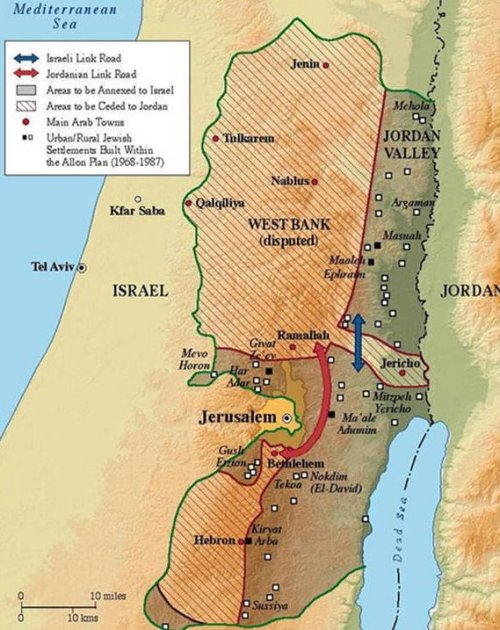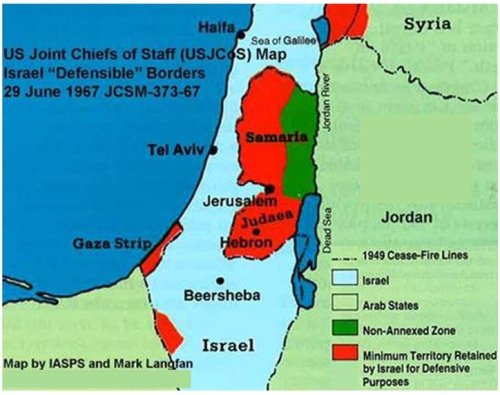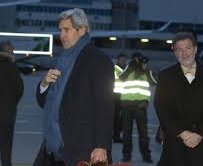One of the peculiar features of the Obama administration has been its apparent belief that it can maneuver against America’s longstanding security posture, and yet continue to subsist inside of it, as if the strength or credibility of it won’t change with the change in policy. Team Obama’s blinders about this clearly extend to the Middle East situation as a whole. That means they extend to Israel’s situation as well.
John Kerry may or may not realize that he is pressing for a security deal on the West Bank (Judea and Samaria) at a time when the regional security situation that forms its context has passed its expiration date. If he doesn’t realize it, we can privately think disparaging thoughts about his intelligence. If he does realize it, well, you decide how you want to react to that.
Post-Pax realities
The bottom line is that it isn’t 1993, or 2003, or even 2008 anymore. 2008 was the year when military analyst and historian Martin Van Creveld published Defending Israel: A Controversial Plan Toward Peace, in which he thrilled some readers and disappointed others by proposing a virtually complete withdrawal of Israeli forces and population from Judea and Samaria, as well as the Golan Heights. In December 2010, he doubled down on the thesis from his book in an opinion piece in the Forward.
Here is how he described Israel’s regional security context at the time:
Though relations with Egypt and Jordan may not always be rosy, both countries have left “the circle of enmity,” as the Hebrew expression goes. Following two-and-a-half decades of astonishing growth, Israel’s GDP is now larger than those of Lebanon, Syria, Jordan and Egypt combined. As to military power, suffice it to say that Israel is the world’s fifth-largest exporter of arms.Van Creveld’s op-ed was published less than four weeks before the Hezbollah coup in Lebanon, which in January 2011 kicked off the Arab Spring. It’s hard to imagine now an antique time in which Egypt could be described, without caveat, as having “left the circle of enmity” around Israel, and Jordan could be considered a stable quantity without U.S. troops deployed in it as a downpayment on an ill-defined American commitment.
Syria, Israel’s main remaining hostile neighbor, has never on its own been strong enough to seriously threaten Israel. While Damascus is getting some weapons from Iran, the latter is no substitute for the genuine superpower patron that Syria had in the old Soviet Union.
Overall, therefore, Israel’s position is much stronger than it was at any time in the past.
It’s equally an effort to recall when an opinion writer could tick off factors in Israel’s security without alluding at all to Hezbollah or Hamas; to growing instability in southern Lebanon, Syria, Jordan, and the Sinai Peninsula; to al Qaeda and other salafists fighting ferociously for territory in Syria; to Iran’s paramilitary Qods force deployed in numbers to Damascus – or to the armed forces of Bashar al-Assad learning how to fight like a 21st-century army and getting their arsenal plused up, once again, by their “superpower” patron to the north.
The Arab Spring and the civil war in Syria have changed Israel’s security context. What it means to talk about “Hezbollah” and “Hamas” has changed: they are not merely terrorists waging a war of one-offs and explosive tactical abstractions – a source of occasional rockets and sniper shots – but a potential nexus, or perhaps path of least resistance (or most cooperation), for military maneuver on Israel’s frontiers.
The conventional military threat is back
It was never wise to downplay the nature of what the organized terrorists could do, even when they were pinned to territory from which they had no realistic hope of launching a destabilizing maneuver campaign. But setting that aside, the threat they represent is not today what it was three years ago. Its character has changed with the regional situation. “Hezbollah” represents a maneuver vulnerability from Lebanon now: Lebanon as a path to Israel from the north.
“Hamas” represents the same thing from the disordered Sinai (if at a slightly more distant remove from the realization of potential). The ultimate conclusion of Egypt’s protracted political agony is by no means foregone, nor can Israel necessarily rely, under future Egyptian governments, on the same well-worn modus vivendi she had developed with the Mubarak regime in administering the peace accord. Since early 2011, the size of Egypt’s military force in the Sinai has expanded significantly in an attempt to pacify the peninsula, and that alone means the facts on the ground for Israel’s security calculations have changed.
The character of the threat from Syria is changing as well. One important thing the civil war there is providing both Assad’s forces and those of the transnational salafists – al Qaeda and others in the opposition – is the opportunity to gain experience in fighting. This is not a negligible opportunity, or one to be dismissed with sarcasm. In spite of our world’s chronic instability, there are never very many places at a given time in which the forces of an armed state are engaged in conventional combat, giving and receiving lessons in tactics, techniques, and weapons performance. The Syrian civil war is teaching a generation to fight:
See how the Syrian army planned for the methodical encirclement and reduction of the rebel forces. They successfully penetrated the rebels communications system and determined their locations before seizing the key terrain piece that dominated the entire area. They quickly adjusted their plans to take advantage of developing situations. They made effective use of combined arms tactics and supporting fires. They conserved their forces for future operations. And they worked effectively with Hizbollah infantry and local militias. That’s coalition warfare. That’s an adaptive, modern military force with effective combat leadership at all levels.As blogger “TTG” projects, we are seeing in these developments an increase in “interoperability and trust” between Hezbollah and Syrian state forces. We need not overestimate the potential for long-term allegiance between them to recognize that forces experienced in operating together can do it again more readily. Israel can’t restrict her concerns now, about either Syria or Hezbollah and Lebanon, to one-dimensional fears of the odd missile launch.
This isn’t because a combined Hezbollah-Syria force has the capability to mount an invasion any time soon. It’s because the potential has increased for this combined threat to operate from a redoubt north of Israel, which it can protect, even in loose federation, and Israel can’t quickly and effectively neutralize. It would be very dangerous at this point for Israel to have to get bogged down in rooting out a threat arrayed in Lebanon and southern Syria. Israel needs to retain the option to quickly and efficiently deny to enemy forces the ability to launch rockets or missiles from the north.
These evolving dimensions of the threat from a northern axis suggest that a UPI report from 19 December is probably correct: Israel is making preparations to – at need, but preemptively – eliminate as much of Hezbollah’s arsenal in Lebanon as she can, in a “short, sharp war.”
Another factor Israel must have her eye on is the quid pro quo Russia has reportedly bribed Assad with, to give up at least a portion of his chemical weapons stockpile. Operating with the Yak-130 Mitten and MiG-29M2 (Fulcrum E) would significantly enhance the Syrian forces’ air-to-ground capabilities – again, not making the Syrians an invasion force capable against Israel, but enlarging the scope of combat activities they can employ and gain expertise in, and hardening them on the margins against Israeli preemption.
Allon, Wheeler, and Kerry-Allen in the context of 2013
Contra Van Creveld’s comfortable assessment of three years ago, Israel’s circumstances are not static today – are not even predictable – on any axis. That puts in perspective the different approaches of two 1967-era concepts for the security of the West Bank. One is the famous “Allon Plan,” named for IDF General Yigal Allon, which proposed sandwiching Arab-held territory in the mountains of Judea and Samaria between coastal Israel and an annexed portion of the Jordan River valley, which would be defended by the IDF and settled by Israelis. (A more extended discussion of West Bank security and the Allon Plan, which I worked up in 2009, is here.)

Allon Plan: Map courtesy of the Jewish Virtual Library at http://www.jewishvirtuallibrary.org/jsource/History/allonplan.html

Wheeler concept: Map by Mark Langfan (courtesy of The Algemeiner: http://www.algemeiner.com/2013/12/20/what-american-generals-knew-about-peace/); security markings in Langfan version redacted by TOC due to declassification of original JCS document in 1979. See JVL: http://www.jewishvirtuallibrary.org/jsource/US-Israel/jt.html
Kerry-Allen reportedly entails early-warning systems for Israel in the mountains of Judea and Samaria, which would otherwise be administered by the Palestinian Authority, largely as they are today. This measure acknowledges the concern reflected in the Wheeler concept for the threat to coastal Israel from the mountain heights.
The IDF would remain in the Jordan Valley for ten years while the PA trained a military force to provide security there. For the long term, the IDF would have a minimal, “invisible” presence at border crossings (what are now security checkpoints). An early version of the plan, according to Palestinian negotiators, involved a U.S./NATO force rather than the IDF to secure the Jordan Valley during the initial 10-year period.
The switch from a NATO force to the IDF in the Jordan Valley, in the Kerry-Allen proposal, appears to concede the Allon Plan’s concern about defending at the Jordan. But the original proposal clearly temporized on that, leaving the defense in the hands of a foreign force of ill-defined status, where the purpose of Allon is for the IDF to be positioned at all times to prevent a crossing of the river. Israel would, of course, be as justified in questioning the exact commitment of a NATO force as she would in questioning what a PA military force would be committed to do, after the 10-year interim. Kerry-Allen appears to be long on process and vague hope, and short on specific guarantees and sovereign discretion for Israel.
In 2013, Israel doesn’t have so many pacified frontiers that she can afford to simply accept vulnerability on one. Of course, reporting on another front suggests she won’t have to: the Palestinian Arab negotiators have rejected the plan already, and the Arab League came out with a rejection of its concept today. (Their main objection is that the plan, in leaving an IDF presence in the Jordan Valley for ten years, is too favorable to Israel.)
The larger and more persistent issue, however, is that conditions do not exist for Israel to agree to set indefensible “borders.” Martin Van Creveld never managed to argue that what Abba Eban called the “Auschwitz borders” – the perimeter defined by the armistice “Green Line” of 1949 with Jordan – were actually defensible. He was able to argue at best that, because of shifting political circumstances, Israel wouldn’t have to defend them. It was questionable whether that was a valid argument in 2008 or 2010; in 2013, it is even more so.
As long, meanwhile, as the actors in the Middle East define sovereign control of Judea and Samaria as a necessary condition of “Palestinian statehood,” that pursuit of statehood will be inextricably linked with the definition of Israel’s borders, and hence of her national security. Attempts to separate the two, by setting up proxies and processes, are unlikely to prosper, except in the most improbably favorable of geopolitical conditions. There is no hope of such conditions today.
For its share in revoking the halcyon conditions in which it was fleetingly possible to propose indefensible borders for Israel, Team Obama can be criticized and perhaps will be judged by history. For continuing to make unworkable security proposals after the conditions of the late 2000s have already disappeared in the rearview mirror, Team Obama should expect only dismissal or silence from the affected parties, offered with varying degrees of politeness.
J.E. Dyer’s articles have appeared at Hot Air, Commentary’s “contentions,” Patheos, The Daily Caller, The Jewish Press, and The Weekly Standard online. She also writes for the new blog Liberty Unyielding.

No comments:
Post a Comment